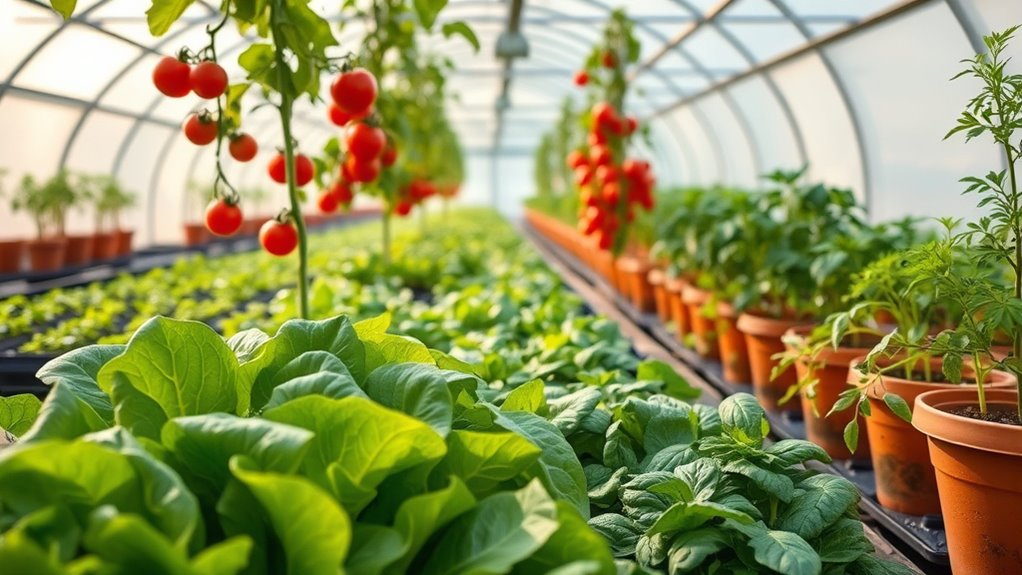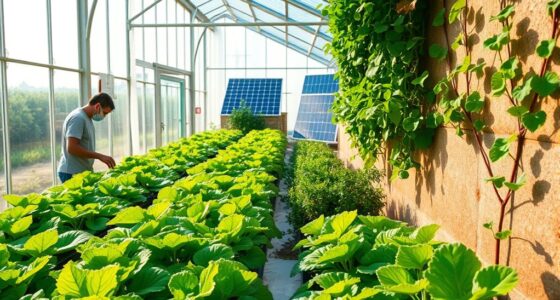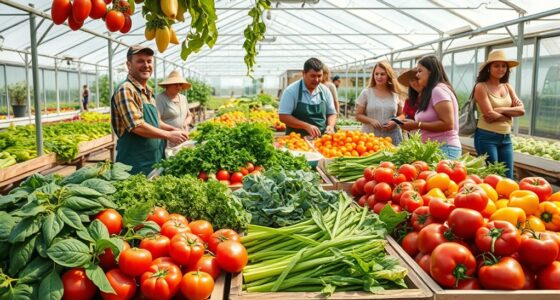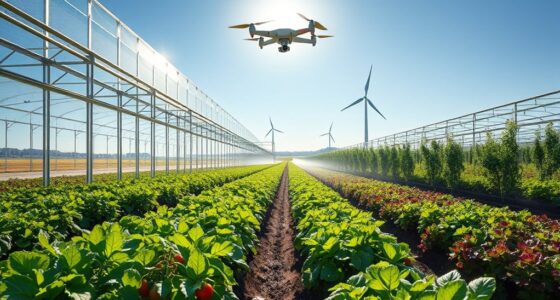If you’re new to greenhouse gardening, start with low-maintenance plants like succulents, herbs such as basil and mint, or small vegetables like lettuce and cherry tomatoes. These crops are forgiving, require minimal attention, and thrive with proper lighting, watering, and soil. They’re ideal for building confidence and enjoying quick results. Keep experimenting with these easy options, and you’ll discover even more tips and tricks to grow a successful greenhouse garden.
Key Takeaways
- Succulents are hardy, low-maintenance plants ideal for beginners, thriving in controlled environments with minimal watering.
- Herbs like basil, mint, and parsley grow quickly and forgivingly, perfect for small greenhouse spaces.
- Tomatoes and lettuce are easy vegetables to cultivate indoors with consistent light, watering, and proper soil.
- Using well-draining soil for succulents and nutrient-rich compost for herbs and vegetables ensures healthy growth.
- Regular monitoring, proper lighting, and simple watering routines make greenhouse gardening accessible for beginners.
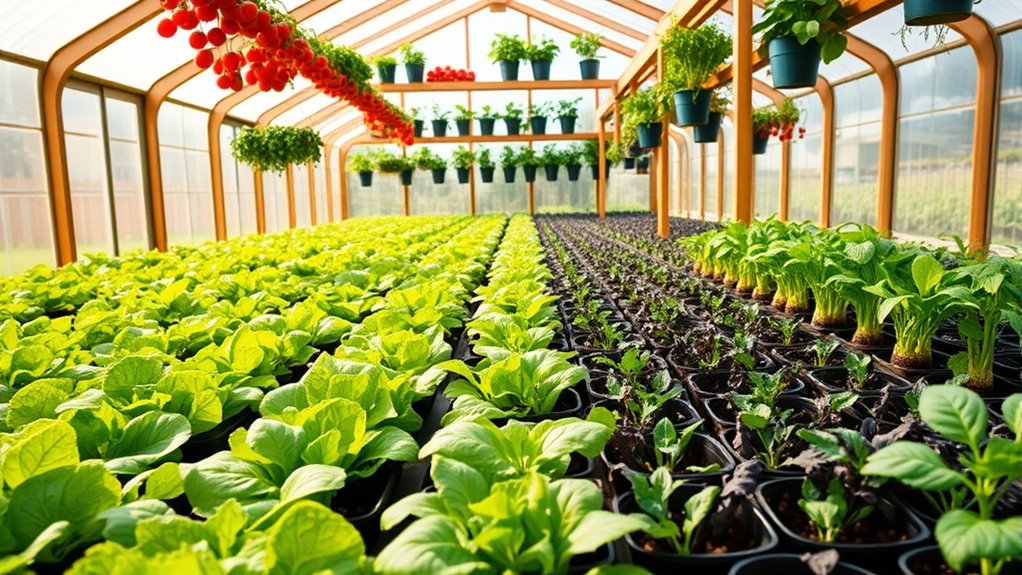
Starting a garden can be rewarding, especially when you choose the right crops to grow. If you’re new to gardening and want to start with plants that are forgiving and easy to maintain, selecting the right crops for your greenhouse is key. For beginners, focusing on resilient plants like certain succulent varieties can make your gardening experience more enjoyable. Succulents are incredibly hardy, require minimal watering, and thrive in controlled environments like greenhouses. They’re perfect for those just learning the ropes because they don’t demand complex care routines. Plus, their unique shapes and textures add visual interest to your indoor garden. Incorporating good lighting is essential for healthy growth, especially in a greenhouse setting. When growing succulents, it’s important to implement simple pest management strategies right from the start. While succulents are generally resistant to pests, issues can still arise if conditions aren’t *conducive*. Keeping your greenhouse clean and well-ventilated helps prevent common pests like mealybugs and spider mites. Regularly inspecting plants allows you to catch any infestations early before they spread. Using natural remedies such as neem oil or insecticidal soap can be effective if pests are detected, and they’re less harsh than chemical pesticides. This proactive approach *guarantees* your succulents stay healthy and vibrant without much fuss. Aside from succulents, other beginner-friendly crops include herbs like basil, mint, and parsley. These herbs thrive in greenhouse environments and are forgiving of minor mistakes in watering or light. They grow quickly, give you fresh flavors for cooking, and require minimal space. Tomatoes and lettuce are also excellent choices. They’re straightforward to grow indoors and can be managed with simple watering schedules and regular monitoring. The key to success with these crops is maintaining consistent humidity and temperature levels, which greenhouses naturally help you control. To *guarantee* your crops flourish, start with good soil or growing mediums suited for each plant type. For succulents, use well-draining soil to prevent root rot, and for herbs and vegetables, choose nutrient-rich compost or potting mix. Remember to provide adequate light—most greenhouse crops need plenty of sunlight or grow lights to thrive. Additionally, understanding the importance of plant nutrition can significantly improve your plant health and yield. Implementing proper watering techniques tailored to each plant’s needs can further enhance their growth and prevent issues like overwatering or underwatering. Watering should be consistent but not excessive; succulents, in particular, dislike overwatering, so let the soil dry out between waterings. Regularly cleaning your greenhouse and staying attentive to your plants’ needs will make your gardening journey smoother and more successful.
Frequently Asked Questions
How Much Space Do Beginner Greenhouse Crops Typically Require?
When determining how much space your beginner greenhouse crops need, consider plant spacing and container sizing. Most easy-to-grow plants, like herbs and leafy greens, require about 6-12 inches of space between each plant. Use appropriately sized containers—around 1-3 gallons—to give roots room to grow without overcrowding. Proper plant spacing and container sizing guarantee healthy growth, maximize your greenhouse space, and make gardening more manageable for beginners.
What Are Common Pest Issues for New Greenhouse Gardeners?
When tackling pest issues in your greenhouse, you should focus on identifying common pests like aphids, whiteflies, and spider mites early. Pest prevention strategies include regular inspections, maintaining good airflow, and keeping your greenhouse clean. By staying vigilant and acting quickly, you can prevent infestations from spreading, protecting your plants and ensuring a healthy greenhouse environment for your beginner gardening journey.
How Often Should I Water My Beginner Greenhouse Plants?
You should water your beginner greenhouse plants based on their specific needs, but generally, check the moisture level daily. Watering frequency varies with plant type, pot size, and environment, so avoid over- or under-watering. Focus on moisture management by keeping the soil evenly moist but not soggy. Stick your finger about an inch into the soil; if it feels dry, it’s time to water. Proper moisture management keeps your plants healthy and thriving.
What Temperature Ranges Are Best for Beginner Crops?
Think of your greenhouse as a cozy nest for your plants. To keep it just right, you need proper temperature regulation, typically between 65-75°F during the day and slightly cooler at night. Seasonal adjustments are key—bring in fans or heaters as needed. Maintaining these temperatures helps your beginner crops thrive, giving them the ideal environment to grow strong and healthy, no matter the season outside.
Are There Specific Soil Types Recommended for Beginners?
For beginners, choosing the right soil is key. You should look for well-draining soil with good aeration, like quality potting mixes. Adding soil amendments such as compost or organic matter improves fertility and structure, making your plants healthier. Avoid heavy, clay soils that retain too much water. Using a good potting mix and enriching it with amendments creates the ideal environment, making your greenhouse gardening easier and more successful.
Conclusion
Starting your greenhouse journey with easy-to-grow crops like lettuce, herbs, and radishes can boost your confidence and yield quick results. Did you know that home gardeners who grow simple crops often see a 30% increase in their gardening success rate? So, don’t hesitate—pick a few beginner-friendly plants, get started today, and watch your green thumb flourish. With patience and care, you’ll soon enjoy fresh, homegrown produce right from your greenhouse.
